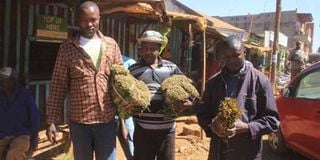Varsity researchers involved in miraa study insist crop is harmful to users

Miraa traders in Lare, Meru County. Governor Peter Munya has requested the Somaliland government to lift trade barriers that have hindered the sale of Miraa in the country. FILE PHOTO | JOSEPH KANYI | NATION MEDIA GROUP
What you need to know:
- The three-member taskforce found that miraa had tremendous impact on consumer’s mental, reproductive and oral health.
- The taskforce was commissioned by the Consortium of National Health through the Ministry of Health in 2014 which sought to establish the impact of miraa on consumers.
- Prof Atwoli also defended the report saying that it was based on current evidence as opposed to ‘fresh research’ to save on resources.
- Dr Ann Mwangi, from the Department of Behavioural Science, said that the research was more of systematic review than actual research.
Researchers from Moi University who undertook a study on the effects of miraa have insisted that the crop undermines the health of users.
Prof Lukoye Atwoli, said that the report they presented to the Ministry of Health and National Health Research was backed by the current information.
“We rated the information of low, medium and high quality. We focused on the high quality to arrive at the findings and recommendations,” said Prof Atwoli.
The three-member taskforce found that miraa had tremendous impact on consumer’s mental, reproductive and oral health.
“The mental effects are either acute or chronic. Studies show that the long-term use of miraa affects the quality of sperm, both the shape and speed of sperm.
“For libido, the use of small quantities of khat seemed to increase sex interest but long-term use affected a person’s interest in sex as well,” added Prof Atwoli.
ESTABLISH IMPACT ON USERS
The taskforce was commissioned by the Consortium of National Health through the Ministry of Health in 2014 which sought to establish the impact of miraa on consumers.
According to Prof Atwoli, the government needs to fund research on the long-term use of miraa as there is low level of research in the country.
He said additional research would provide more evidence that applies on the local population.
Prof Atwoli also defended the report saying that it was based on current evidence as opposed to ‘fresh research’ to save on resources.
He also reacted to criticism by leaders from Meru County who have termed the report as ‘misleading’.
“It is natural for people to read and quickly jump to conclusion that miraa is good or bad.
TELL THE EFFECTS
“As scientists, ours is to tell you the effects. It is up to the consumers of that information to decide what to do with information.
“It not our place to tell anyone how to deal with miraa trade or farming, our job is to generate the evidence which will inform the national and county governments’ policies as far as Miraa is concerned,” said Prof Atwoli.
Dr Ochiba Likandu, the lead researcher from the Department of Oral and Maxillofacial Surgery, Oral Medicine, Oral Pathology and Radiology, rubbished reports that there was no link between miraa and oral or any other cancer.
Dr Ann Mwangi, from the Department of Behavioural Science, said that the research was more of systematic review than actual research.
Meru County Senator Murungi took to social media last week to condemn the report insisting that the National Assembly had made an amendment to the Crops Act that declared the plant as a cash crop.
Agriculture, Livestock and Fisheries Executive Jenaro Guantai Gatangugi wrote a protest letter to Moi University saying the crop should not be 'played’ with as it sustained many lives and that the county was not consulted when the document was prepared.





